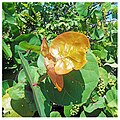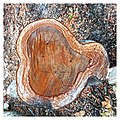|
Coccoloba uvifera
Coccoloba uvifera is a species of tree and flowering plant in the buckwheat family, Polygonaceae, that is native to coastal beaches throughout tropical America and the Caribbean, including central & southern Florida, the Bahamas, the Greater and Lesser Antilles, and Bermuda. Common names include seagrape and baygrape. FruitIn late summer, it bears green fruit, about 2 cm (0.79 in) diameter, in large, grape-like clusters.[3] The fruit gradually ripens to a purplish color. Each contains a large pit that constitutes most of the volume of the fruit.[citation needed] Cultivation and propagationAlthough it is capable of surviving down to about 2 °C (35.6 °F), the tree cannot survive frost.[4] The leaves turn reddish before withering. The seeds of this plant, once gathered, must be planted immediately, for unlike most plants, the seeds cannot withstand being stored for future planting.[citation needed] C. uvifera is wind-resistant,[5] moderately tolerant of shade, and highly tolerant of salt, so it is often planted to stabilize beach edges; it is also planted as an ornamental shrub. The fruit is very tasty, and can be used for jam or eaten directly from the tree. The shrub is low maintenance and largely disease and pest free. Sea grape does have one minor pest, the sea grape borer, which is a moth native to florida that bores into small twigs and branches and kills them along with their leaves. The damage, however, is usually minor. The leaves of the sea grape are also slow to decompose, which may cause some annoyance for homeowners.[citation needed] Sea grape is a dioecious species, that is, male and female flowers are borne on separate plants, and cross-pollination is necessary for fruit to develop. Honey bees and other insects help pollinate these plants;[6] male and female plants can be distinguished by the appearance of their flowers, as males usually show dead flower stalks.[7]
Uses
Coccoloba uvifera is a popular ornamental plant in south Florida yards. It serves as a dune stabilizer and protective habitat for small animals. Tall sea grape plants behind beaches help prevent sea turtles from being distracted by lights from nearby buildings. The sap has been used for dyeing and tanning leather. The wood has occasionally been used in furniture, as firewood, or for making charcoal. The fruits of the sea grape may be eaten raw, cooked into jellies and jams, or fermented into sea grape wine.[8] The leaves of the sea grape can be made into a tea and honey bees can make a certain type of honey with the nectar of the sea grape flowers. In other places native to sea grapes, various parts of the plant are used for medicinal purposes. For example, in Puerto Rico and the Caribbean the roots and bark of the plants are used in traditional medicine, while in the Yucatán peninsula tea made from the bark of sea grape mixed with alcohol is used for ulcers. In French Guiana, a juice made from the whole plant called Jamaica kino, is used to treat diarrhea and dysentery.[citation needed] ClassificationThe first botanical names of the plant[9] were assigned in 1696 by Hans Sloane, who called it Prunus maritima racemosa, "maritime grape-cluster Prunus", and Leonard Plukenet, who named it Uvifera littorea, "grape-bearer of the shore", both of which names reflect the European concept of "sea-grape", expressed in a number of languages by the explorers of the times. The natives viewed it as a large mulberry.[citation needed] The first edition of Linnaeus's Species Plantarum (1753), based on Plukenet, assigned the plant to Polygonum uvifera and noted flores non vidi, "I have not seen the flowers." Subsequently, Patrick Browne, The Civil and Natural History of Jamaica (1756) devised Coccoloba for it. Relying on Browne, Linnaeus' second edition (1762),[10] changed the classification to Coccolobus uvifera, citing all the other names. Coccoloba comes from the Greek kokkolobis, a kind of grape, literally, "berry pod".[11] Gallery
References
Wikimedia Commons has media related to Coccoloba uvifera.
|
||||||||||||||||||||||||||||||||||




















